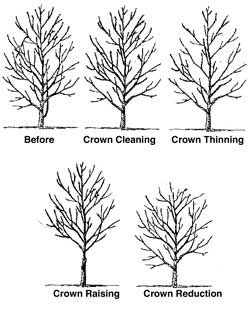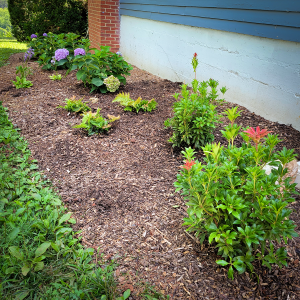 Pruning is the most common tree maintenance procedure. Although forest trees grow quite well with only nature’s pruning, landscape trees require a higher level of care to maintain their safety and aesthetics. Pruning should be done with an understanding of how the tree responds to each cut. Improper pruning can cause damage that will last for the life of the tree, or worse, shorten the tree’s life. Proper pruning, with an understanding of tree biology, can maintain good tree health and structure while enhancing the aesthetic and economic values of your landscape.
Pruning is the most common tree maintenance procedure. Although forest trees grow quite well with only nature’s pruning, landscape trees require a higher level of care to maintain their safety and aesthetics. Pruning should be done with an understanding of how the tree responds to each cut. Improper pruning can cause damage that will last for the life of the tree, or worse, shorten the tree’s life. Proper pruning, with an understanding of tree biology, can maintain good tree health and structure while enhancing the aesthetic and economic values of your landscape.
When to Prune Trees
Trees that shed their leaves annually are classified as deciduous trees. Pruning deciduous trees and shrubs at different seasons triggers different responses. In the Charlottesville area, late winter or early spring, before bud break, is a good time to prune many tree species because callus tissue forms rapidly. When pruning flowering trees, take care not to cut off flower buds. Some trees, such as cherry, plum, and crabapple, form buds on old wood. Others, such as crape myrtle, bloom on new wood.
Summer pruning tends to suppress growth of both suckers and foliage. Late summer or early fall pruning causes vigorous regrowth, which in some species may not harden off by winter, leading to possible cold damage. Whenever unexpected damage from vandalism or bad weather occurs, prune immediately
Evergreen trees have leaves that persist year round, and include most conifers and some broad-leaved trees. Evergreen trees generally need less pruning than deciduous trees. Most evergreen pruning is done for corrective reasons, so seasonal timing is not as important as it is for deciduous species. Pruning during dormancy is the most common practice and will result in a vigorous burst of spring growth.
Whenever possible, avoid pruning evergreen trees in late summer and early fall. Pruning at this time can stimulate new growth that may not harden off before winter, and thus may be damaged or killed by the cold.
Whenever unexpected damage from vandalism or bad weather occurs, prune immediately.
Types of Tree Pruning
 Specific types of pruning may be necessary to maintain a mature tree in a healthy, safe, and attractive condition.
Specific types of pruning may be necessary to maintain a mature tree in a healthy, safe, and attractive condition.
Cleaning is the removal of dead, dying, diseased, crowded, weakly attached, and low-vigor branches from the crown of a tree.
Thinning is the selective removal of branches to increase light penetration and air movement through the crown. Thinning opens the foliage of a tree, reduces weight on heavy limbs, and helps retain the tree’s natural shape.
Raising removes the lower branches from a tree in order to provide clearance for buildings, vehicles, pedestrians, and vistas.
Reduction reduces the size of a tree, often for clearance for utility lines. Reducing the height or spread of a tree is best accomplished by pruning back the leaders and branch terminals to lateral branches that are large enough to assume the terminal roles (at least one-third the diameter of the cut stem). Compared to topping, reduction helps maintain the form and structural integrity of the tree. Advantages of thinning include better air circulation, improved sunlight penetration, and less wind resistance.
What Part of the Tree to Prune
Corrective pruning removes damaged wood and eliminates rubbing branches. When pruning dead or diseased branches, make cuts into healthy wood, well below the affected area. Disinfect tools between each cut with products such as “Lysol,” “Listerine,” or rubbing alcohol. Tests have shown that “Pine-Sol” and household bleach are highly corrosive to metal tools.
Remove rubbing or poorly placed branches as early as possible. To avoid splitting, make a thinning cut to remove one branch. Water sprouts and suckers always interfere with normal growth, so prune them off completely as they appear.
Don’t coat pruning cuts with tree paint or wound dressing, except in special circumstances. Some tests have shown wound dressings are beneficial when pruning trees that are susceptible to canker or systemic disease (oak wilt and Dutch elm disease). Tree paint won’t prevent decay or promote wound closure, but may prevent disease-carrying insects from entering tree wounds. The best way to prevent oak wilt and Dutch elm disease, however, is to avoid pruning oaks and elms in May and June when insects are more active.
To learn more about the best time to prune shrubs download the Shrub Pruning Calendar courtesy of the Virginia Cooperative Extension. (pdf)
At Dos Amigos Landscaping we have the expertise to prune your trees and shrubs properly for maximum health and beauty of your trees, shrubs and landscaping. Right now (January to March) is the best time to prune most deciduous trees in Virginia. Contact us today we’ll come to your property, make an assessment and give you an estimate for pruning. Call our Office Manager, Daniel Martin at 434-465-0075 to schedule an appointment or send an email.


